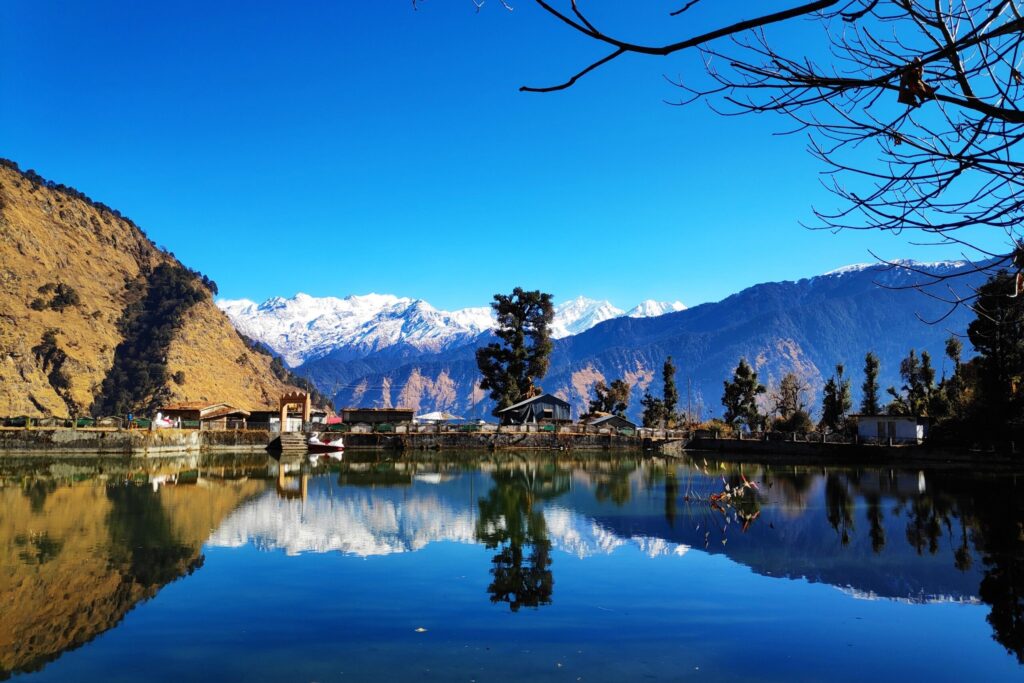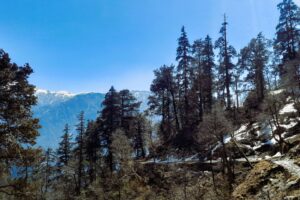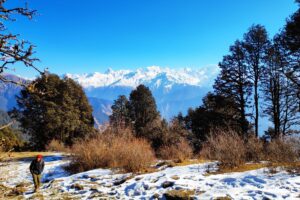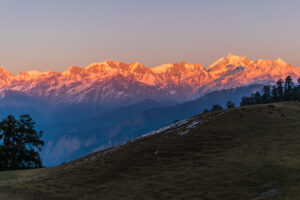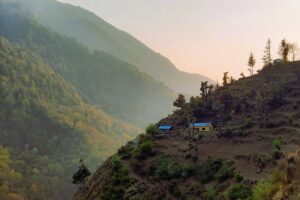- Overview
- Trip Outline
- Trip Inclusion
- Trip Exclusion
- Gallery
- Booking
- FAQs
Dayara Bugyal: A High-Altitude Meadow Paradise
Spanning an area of 28 square kilometers, Dayara Bugyal is one of India's largest high-altitude meadows. Nestled in the Gangotri valley, this trek offers unparalleled vistas of the Garhwal Himalayas. As yogis claim, every peak here holds a unique story. You can almost touch towering peaks like Bandarpoonch, Srikanth Kailash, and Draupadi Ka Danda! The trail to the Bugyal leads through enchanting coniferous, maple, and rhododendron forests. April is a particularly magical time when rhododendron blooms paint the forest in vibrant shades of red.
Best time to do the trek
- Mid March to Mid May
- Mid Sept to Dec End
The Area
Dayara is situated near Uttarkashi in the Gangotri valley, within the Garhwal region of Uttarakhand. Uttarakhand, also known as "Dev Bhoomi" (Abode of Gods), is a significant Hindu pilgrimage destination. The native language is Garhwali, and the local people are often referred to as "Pahadi" (Mountain folk).
Expected Weather
March-May:
- Rain/ Hail: Mild Drizzle
- Snowfall: Possible in March, December
- Temperatures:
- Afternoon: Up to 20 degrees Celsius (May)
- Night: Around -2 degrees Celsius (May) at higher camps
- Snow on trail: Likely in March, early April
September-December:
- Rain/ Hail: Mild to moderate drizzle can be expected in September.
- Snowfall: Possible snowfall in December.
- Temperatures:
- Afternoon: Up to 20 degrees Celsius (September)
- Night: Around -5 to -8 degrees Celsius (December) at higher camps
Day 1: Drive from Dehradun to Raithal
- Drive: Travel from Dehradun to Raithal (1800 mts).
- Overnight: Stay overnight in a hotel in Raithal.
Day 2: Raithal to Gui
- Trek: Hike from Raithal to Gui (2925 meters).
- Distance: 5 kms. Time: 4 hrs
- Overnight: Stay overnight in camps at Gui.
Day 3: Gui to Dayara Bugyal
- Trek: Trek from Gui to Dayara Bugyal (3440 mts).
- Distance: 4 kms. Time: 4 hrs
- Overnight: Stay overnight in camps at Dayara Bugyal.
Day 4: Dayara Bugyal to Bakaria Top and Back
- Trek: Hike from Dayara Bugyal to Bakaria Top (3807 mts) and return to Dayara Bugyal.
- Distance: 8 kms. Time: 6 hrs
Day 5: Dayara Bugyal to Barsu and Drive to Dehradun
- Trek: Trek from Dayara Bugyal to Barsu (2300 mts)
- Distance: 8 kms. Time: 5 hrs
- Drive: From Barsu back to Dehradun.
-
- Accommodation: Complete accommodation throughout the trek, including Raithal on the first and last days.
- Food: All meals starting from dinner on the first day to dinner on the second-to-last day.
- Equipment: Rental of essential common gear such as tents and sleeping bags.
- Permits: Forest entry permit fees.
- Guidance: Services of a professional guide and their expertise.
- GST: 5% Goods and Services Tax (GST) on applicable items.
- Medical First Aid Kit: High altitude first aid kit, stretcher, oxygen cylinder.
-
- Personal Purchases: Meals or beverages purchased by participants during travel or the trek (e.g., snacks, fruits).
- Personal Gear: Rental fees for personal equipment (refer to the "Things to Carry" section for recommended items).
- Trek Insurance: Optional travel insurance.
- Transportation: Transportation to and from Dehradun, as well as transportation to and from Raithal.
- Porterage. Participants can carry their own backpacks. Those unable to do so can opt for a porterage service at ₹350 per day.
Dehradun Airport (Jolly Grant) is the closest
Raithal is 180 kms from Dehradun. One can reach here by booking a cab from Dehradun. We can help you with that, if assistance is needed). The cost of the cab will be approximately 6000 INR (For a Bolero or similar vehicle. Innova/ Ertiga costs more) For people wanting to use public transport, one can get shared cabs and buses for Uttarkashi from Dehradun. From Uttarkashi you will have take a cab till Raithal. Note, it is advisable to book a cab to avoid inconvenience.
Yes, this trek is ideal for first timers.
A certified trek leader, a guide, cook & porters will accompany you during the trek
No. Guests are expected to carry their own power banks.
We’ve been organizing treks for over five years and have had many female trekkers trek with us. In fact, a lot of them come solo for treks. There has never been a complaint about the atmosphere of a trek, about other trekkers or our professionalism. They have all been kind enough to leave a review.
In all the camps where the accommodation is in tea houses/ home stays, there will be proper toilets. The toilets are mostly western, incase if they‘re Indian, then we try to provide a toilet seat most of the times.
On the day of camping, we will have toilet tents (with a dry pit toilet), the most hygienic way of answering nature’s call.
A dry pit toilet is an eco-friendly sanitation solution featuring a pit dug into the ground, topped with a toilet seat and a wrought iron stand. Near the toilet, a pile of mud, sand, or coco peat is provided for covering waste after use, facilitating rapid breakdown of fecal matter due to increased microbial activity. This method eliminates the need for water, thereby preventing contamination of nearby water sources, as water toilets are prohibited at campsites.
While toilet paper is available, please use it sparingly to avoid overloading the pit, which can take years to decompose. Please refrain from using wet wipes as they are not bio degradable or use bio-degradable wipes.
Through the trek, there are no bathing facilities at campsites. Trekkers often take advantage of running streams to freshen themselves up.
You can prepare for the trek with a combination of Cardio & Strength activities
2-3 kms slow jog OR 5-6 kms of brisk walking OR 10 kms cycling. Pace is not important, consistency is important (non-stop jogging/running/cycling)
Squats 15 x 3, Lunges 15 x 3, Calf raises 15 x 3
All of the above at least 4 times a week
Climbing stairs 15-20 floors with backpack (At Least once a week)
Yes, you are ideally expected to carry your backpack. But you do have an option of offloading your bags on a mule for an additional cost. The cost will be INR 400/ per day per bag (weight not exceeding 8kg). One is expected to inform us about offloading 1 week prior to the trek.
1. Good Sturdy Backpack: Prefer a trekking pack over a backpacking one. The size of the backpack depends upon the participant. Normally for a 5-6 day trek a 40-50 litre pack should suffice.
2. Shoes: Any waterproof trek (not hike) shoe would be ideal.
3. Socks: 3 pair cottons and 3 pairs of woollens.
4. Trek pants (ideally water resistant): Get two trek pants on this trek, both should be slightly thick, winter trekking pants. If you don’t have a trek pants, you can replace it with thick Gym track pants too. Don’t trek in jeans/ pants.
5. T-shirt/ Base layer: Get 2 T-shirts/ trekking base layer on the trek, both of which should be thick and full sleeve. Avoid cotton and prefer dry fit.
6. Fleece/ Sweater/Good quality Hoodie: Get 1 fleece jacket or sweater. Fleece is preferred over sweater as it is lightweight and easy to carry. Sweaters and Jackets can be heavier than Fleece for the warmth they offer.
7. Down/ Padded Jacket: Down/ Padded jacket (Up to -10 degrees capacity) is a must for winter treks. If you are not sure about the quality of your padded/ down jacket, get two fleeces.
8. Thick track pants for camp: These are specifically for cold evenings at the campsite. This can be ignored if you are comfortable wearing your thick trekking pants in the camp.
9. Thermals: 1 pair. We wear thermals only upon reaching the campsite not while trekking. For treks in December, January and February, trekkers who are doubtful about their layers can get 2 lower thermals.
10. Windproof Jacket: All rain proof can be used as wind proofs. Required as an additional layer during trekking in windy conditions. Avoid if you have a rain proof jacket.
11. Rainwear:
Option 1 – Rain set: One Waterproof jacket (3000 mm waterproofing), Rain proof pants and Bag cover
Option 2 – Poncho: Covers your body and bag completely.
We recommend Option 1 as poncho makes trekking difficult.
12. Woolen Cap/ Balaclava – 1: To cover your ears and head. Get a thick fleece lining one for winter treks
13. Neck Warmer/ Scarf - 1: For evenings.
14. Gloves: 2 gloves out of which 1 can be water proof and one woollen. The waterproof one has to ideally be padded and a size larger than you normally use so that you can wear both your gloves together if required.
15. Suncap – 1
16. Sunglasses – 1
17. Toiletries – Also include sunscreen, moisturizer and lip-cream
18. Headlamp/ Torch (Prefer a head lamp) -1
19. Two water bottles (1 litre each) – One can be a thermos flask.
20. Camp shoes/ Flip flops for camp
21. Plastic covers for inside the backpack to keep your clothes dry
22. Daypack – Required if you have a summit days climb. Preferably one that can be compressed.
23. Documents: 2 passport sized photograph, Address and Photo proof (Driving License or Aadhaar card), Doctor’s medical certificate saying that you are fit for the trek. We reserve the right to not take you on the trek, if you fail to produce this.
24. Trekking pole
The common perception is that alcohol makes you feel warmer, however it also dehydrates you & dehydration can be fatal while trekking. Hence consumption of alcohol is prohibited. Smoking in camps is not allowed.
Wild animals do not frequent camps. They tend to stay away.
If you cancel –
– 60 days before the trip: we can process a complete refund minus minimum processing charges.
– Between 30-45 days before the trip: you will be refunded 50% of the trek fee.
– Within 30 days before trek starts: No refund.
– If your spot is replaced in a full batch: we will process a complete refund after cancelling minute operational charges. (For fixed departures only)

